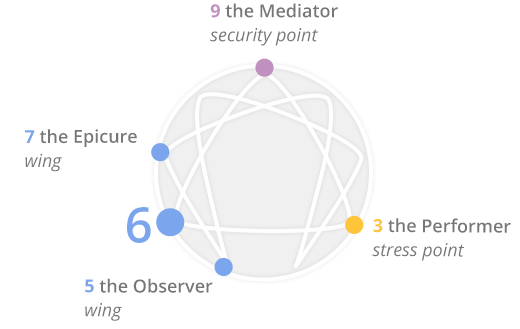*This was updated in April 2020. If you find it helpful, leave a comment or grab me a cup of coffee.
I’m a 6 wing 7.
I’ve learned to embrace this reality because ignoring it wasn’t working and lying to myself doesn’t do much good in the long run. Being a Loyalist / Troubleshooter certainly isn’t the sexiest number to have in a culture that glorifies risk-takers, performers, and hard-charging leaders. However, the Enneagram isn’t about good or bad… it’s simply a tool to help you move towards a healthier version of yourself.
Being an honest and self-aware version of myself is best for me and my family. In the photo is my wife Katherine (who’s pregnant with our 4th), Felix, Jubilee, and Clara.

OVERVIEW OF TYPE 6
In case you stumbled across this post without a basic understanding of type 6, here’s one of the better short explainer videos.
EMBRACE YOUR 6-NESS
When I first realized I was a 6, I was so disappointed by my tendencies towards anxiety, fear, and strong awareness/distrust of leadership. Discovering I was a 6 also explained why I sometimes can’t trust myself or the decisions I make.
However, being vocal about your shortcomings without finding a solution is a victim mentality. That’s the kind of thinking I don’t want to foster.
So… as a result, I’m proud of my 6-ness because it means…
- I’m deeply committed to people
- I can create security and safety for others as a leader
- I’m engaging and responsible
- I can visualize scenarios or pitfalls in my head before they happen
- I’m keenly aware of the greater good and will fight for it
- I’m a strategic thinker
THIS IS AN AD
LEVELS OF A SIX

The above is a diagram was created by Enneagram Worldwide and best visually represent type 6.
Each type has 9 levels of health as outlined below, which is an excerpt of the Enneagram Institute’s Type 6 page. These levels indicate if we are moving towards Health (Security Point or Integration) or Stress (Disintegration).
Healthy Levels
Level 1 (At Their Best): Become self-affirming, trusting of self and others, independent yet symbiotically interdependent and cooperative as an equal. Belief in self leads to true courage, positive thinking, leadership, and rich self-expression.
Level 2: Able to elicit strong emotional responses from others: very appealing, endearing, lovable, affectionate. Trust important: bonding with others, forming permanent relationships and alliances.
Level 3: Dedicated to individuals and movements in which they deeply believe. Community builders: responsible, reliable, trustworthy. Hard-working and persevering, sacrificing for others, they create stability and security in their world, bringing a cooperative spirit.
Average Levels
Level 4: Start investing their time and energy into whatever they believe will be safe and stable. Organizing and structuring, they look to alliances and authorities for security and continuity. Constantly vigilant, anticipating problems.
Level 5: To resist having more demands made on them, they react against others passive-aggressively. Become evasive, indecisive, cautious, procrastinating, and ambivalent. Are highly reactive, anxious, and negative, giving contradictory, “mixed signals.” Internal confusion makes them react unpredictably.
Level 6: To compensate for insecurities, they become sarcastic and belligerent, blaming others for their problems, taking a tough stance toward “outsiders.” Highly reactive and defensive, dividing people into friends and enemies, while looking for threats to their own security. Authoritarian while fearful of authority, highly suspicious, yet, conspiratorial, and fear-instilling to silence their own fears.
Unhealthy Levels
Level 7: Fearing that they have ruined their security, they become panicky, volatile, and self-disparaging with acute inferiority feelings. Seeing themselves as defenseless, they seek out a stronger authority or belief to resolve all problems. Highly divisive, disparaging and berating others
Level 8: Feeling persecuted, that others are “out to get them,” they lash-out and act irrationally, bringing about what they fear. Fanaticism, violence.
Level 9: Hysterical, and seeking to escape punishment, they become self-destructive and suicidal. Alcoholism, drug overdoses, “skid row,” self-abasing behavior. Generally corresponds to the Passive-Aggressive and Paranoid personality disorders.
HOW SIXES MOVE TOWARDS HEALTH
Aside from realizing that the Enneagram is a tool to help and not a box to place you in, the next best thing to learn is practical steps to apply that tool. Most Enneagram resources are so theoretical, which drives me crazy.
So, here are some practical steps to turn the knowledge of the Enneagram into transformative actions for sixes like myself!
- Subscribe: The Enneagram Institute has a game-changing resource that emails you tips and mindfulness triggering emails every day to help you recognize your personality at work each day. I’ve been subscribed for over a year and it consistently moves me towards health.
- Start Journalling
- As mentioned previously, the small and simple act of writing down what happened that day has brought a new measure of clarity and peace to my life.
- Read The Road Back to You by Ian Morgan Cron and Suzanne Stabile or listen to Ian’s Typology Podcast
- Start asking “What’s the best that could happen?”
- We tend to ask the “worst case scenario” questions. Start to see the positive outcomes of risks as a way to balance your lopsided inner monologue.
- Embrace Day-Dreams, suppress Day-Mares
- If you are unfamiliar with the term, Daymare, it’s when you visualize bad things happening while you are awake. It’s kinda like a nightmare, but you’re awake. As a six, I can daymare with the best of them, but ever since I heard the song “A Million Dreams” from The Greatest Showman I see things differently. Take a listen for yourself…
WHAT’S PHOBIC VS. COUNTERPHOBIC?
Sixes are unique in the sense that our number can manifest in two different primary ways. The most insightful and easy to understand explanation of this nuance I have found is in this video…
UNDERSTANDING THE SIX WINGS (5 and 7)
It didn’t take me long to know what wing I was off of 6, but it can be difficult. If you are struggling to discover your wing, here is a video that contrasts the two nicely.
CAREER IMPLICATIONS FOR TYPE SIX?
Saying that any one career path for sixes is ideal would be foolish. Personality isn’t the only factor in job performance. There is decision making, leadership, technical skills, training and more to consider. I do think we should be asking ourselves a series of questions as we evaluate our career.
When we answer these questions honestly, we’ll unearth the positive, courageous and self-affirming leader we’ve been waiting to become.
- How is my need for the security sabotaging my growth?
- How can I use my risk assessment skills to be a catalyst for taking risks in my own life?
- Who have I been passive aggressive towards and how can I practice healthy conflict instead?
- In what ways have I fostered the seeds of indecision and procrastination?
- If I address my problems or take positive risks today, what’s the best that could happen?
- How will I feel in 5 years if nothing changes due to my procrastination and indecision?
- How can I practice self-expression?
That last one about self-expression is a painful one for me. When I was in elementary school, I had an art teacher give all the students paint brushes and a blank canvas. She played music and said that we were supposed to use the next 5 minutes as “free flow” painting time. We were supposed to let the music guide the art we were making.
I’m not sure if what I made was just really bad art or I somehow misunderstood her instructions, but at the end of the painting time she took what I made and said, “You did it all wrong.” It’s taken a long time to realize how that impacted me and pushed me away from self-confidence into someone who feels like they don’t belong in the seat at the table.
There is hope for those wishing to come out of insecurity and into a life of creative expression. This blog is one example of my own victory towards a life of courage. My suggestion is to find what makes you tick (for me it’s helping people) and do that for as many people as you can as often as you can. The money will eventually follow.
In the Workplace
If you’re in business and you need insight on your team members in order to improve communications and productivity, the Enneagram can be a great tool to help with this. There’s a tool called Crystal, that uses the Enneagram, DISC, Myers-Briggs and other personality tools to give you personalized, situation-specific advice to communicate more effectively. You can get started with Crystal here.
DIET / FITNESS IMPLICATIONS
As someone who has struggled with body weight and self-image since a very young age, talking about how my personality may be shaping my physical being is a touchy subject. It can make me feel like a victim of something I can’t control. However, I want to put those feelings aside and focus on what is controllable.
In my research, one of the most practical and impactful analysis of how sixes handle diet & health came from this post on Dietnosis.com. Here are a few highlights that I found especially relevant…
Impulse Control & Stress
“… Sixes are highly reactive, excitable and sensitive to stress. They take workplace stress personally and feel that it is their personal responsibility to solve problems. They may feel more tense, worried or discouraged under stress than other Types. Stress affects their ability to resist temptations, especially food temptations that feel nurturing, traditional, and safe. Therefore managing stress should be a part of any weight loss program.”
AND
“Sixes may find themselves eating even though they are not hungry when they do not feel secure, when they feel anxious, uncertain about the future, or have to make a big decision. They eat to quite the inner worry-wart. It is key that Sixes recognize these fearful eating triggers so that they can learn to cope with them.”
Relying on a System
“When choosing a self-improvement regimen Sixes prefer tried-and-true methods. They are more comfortable with a step-by-step plan that doesn’t move too fast or make them prone to injury. Sixes also thrive with tracking measures, routines or memberships that increase their accountability.”
AND
“They tend to do the same workout over and over, without getting bored. This consistency can be good for steady growth but bad for getting out of a exercise plateau.”
BONUS / RESOURCES
Research for this post came from the following resources.
- The Enneagram Institute
- The Road Back to You by Ian Morgan Cron and Suzanne Stabile
- The Typology Podcast
- Enneagram Worldwide
- Enneagram Girl
- Joshua French
Sleeping at Last Podcast
A musician I’ve enjoyed for several years that goes by the name Sleeping at Last has a podcast that breaks down the origin stories of his songs. At the time of writing this post, he was in the middle of a series on his podcast where he is writing a song for each Enneagram type and discussing the type with the author of The Sacred Enneagram, Chris Heuertz.
Here is the full episode breaking down the Enneagram 6 and his song titled “Six“.
WAS THIS HELPFUL?
I don’t ask in order to make myself feel better. I really want to know if this is helpful in your life. If so, leave a comment below and let me know a little about your journey as a 6. If you want to do more, the only form of payment I accept (as a dad of four) is a cup of coffee.

Josh Michael
I'm a lifelong learner, Enneagram 6w7, and dad of four. I wrote this to help you realize your super powers as a Six & harness them for good! If you enjoyed this, consider saying thanks in the best way possible.

Thanks for the article. One note, The Road Back to You is by Ian Cron AND Suzanne Stabile.
Thank you so much for pointing this out Amy! That’s my fault and it’s updated now!
I am a 6 with wing 5, the anxiety is deafening! I have read the Road Back to You and now reading Personality Types by Don Richard Riso and Russ Hudson. I also have a wonderful personal trainer who has helped me immensely. The one area I’m not making progress in is the eating/ nutrition area which is driving this poor thinking mind insane! The impulse eating and poor planning are difficult for me as I have a high-stress job and exhausted at the end of the day. The need for a step-by-step plan does not make sense to my trainer and his mindfulness practice (which I do use successfully to help with other areas of my life) does not make sense to me in this area. Any additional “tried and true” help and support would be great! Can you lead me to a good website or resource to help me? Thank you.
Christine, if you find the solution… please tell me! 🙂
In all seriousness, I’ve been contemplating this a lot lately and I’m convinced that a step-by-step plan is only a short-term fix. Also, I don’t think mindfulness when it comes to eating is a long-term solution. Our minds are hardwired to create shortcuts & operate efficiently. The main way this happens is through habits. A lot has been said on the topic, but the more I study… manipulating our habits to work for us is the only long-term fix to this.
A good resource on this is Donald Miller’s interview with James Clear titled ‘How to Hack Your Habits to Achieve Lasting Change’. James Clear is the author of a book called, Atomic Habits, which has been recommended to me, but I have not read yet.
I’m so glad I came across this blog post/article haha. I’m a 6 as well, and even though I haven’t read everything I can relate. The way you laid everything out very concisely and straight to the point is refreshing. I hate reading things that’s sporadic and everywhere. I appreciate this post and saved it to my bookmarks just to bounce back on it. Happy New year’s to you and your family as well!
I’m glad you found it helpful, Jalen!
Thank you, thank you, thank you for this! I am also a 6w7 and in doing research to try and understand myself more I was frustrated by the lack of practical advice I could find. Knowing what type I am is great but what do I do with that info? You helped answer that question perfectly! Bookmarked this so I can refer back when needed.
Thanks for the positive feedback!
I’m very new to the enneagram and trying to understand my 6-ness. I found your guide very helpful and strait forward. Thanks!
Thanks for the feedback, Deb… best of luck in your research!
This was incredibly helpful! I will probably be re-reading this time and time again. Also a 6w7 with many years of focus on managing anxiety – but I absolutely didn’t understand that it was so heightened in myself. I thought all humans felt anxiety like this! It’s incredible to imagine people who don’t double back and question so much.
“What’s the best thing that can happen?” as a question to use to trigger my imagination to think of positive things, has already helped.
Your approach to this post and your natural honesty has been really appreciated over here. 🙂
Carol, it means a lot to hear the impact this has had. Thanks for sharing!
Hello,
This is Sandi. I write Enneagram blog at EnneagramTestPersonality.com. May I ask you if your are interested in link exchange? Google really takes into account backlinking with relevant content. I already have some successful partnership with personality tests content websites.
I am pretty sure that we have a lot of relevant content for each other. 🙂
Please let me know what are your thoughts!
Sandi
Sandi, thanks for the interest. I’m happy to leave this in the comments for people to discover.
I like how you put this together. I’m searching for a way to dream about my future in my 6ness.
I’m glad you found it helpful!
Great post!! Thank you for sharing your insight!!
This is helpful! I am just starting to embrace my enneagram, and truly understand what it means and how to strive to live purposefully in the “6” that I am. Your practical steps and resources listed in this guide are so helpful!
Glad you found it helpful, Caitlin! Blessings, Josh.
It is my understanding from Claudio Naranjo that wings are a misconception and and a very out dated concept.
I consider myself now a counter phobic six and was miss identified for years as an 8.
Thanks Josh. Great succinct page. I was pretty sure I am a 6w7, but not clear (5 seemed strong too), but this pretty much cleared up the confusion. And found helpful the suggestions for how to relax this fixation.